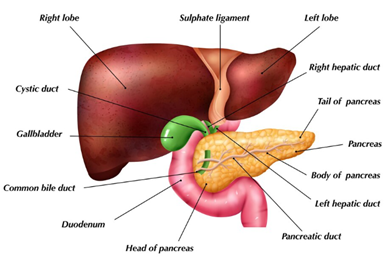This sheet answers common questions about gallbladders polyps and the implications they have. If you would like further information, or have any particular worries, please do not hesitate to ask your surgeon, nurse specialist or another member of the team. In all cases, a doctor will explain the condition to you and answer any questions you may have.

What is my gallbladder?
Your gallbladder is a small sac that is attached to the bottom of your liver. It stores and concentrates bile, which is a liquid produced by your liver to help you absorb and digest fats.
Your gallbladder is not an essential organ. Should you need an operation to remove your gallbladder (a cholecystectomy), then your surgeon will discuss this with you in more detail.
What is a gallbladder polyp?
A gallbladder polyp is a small growth within the gallbladder. They are relatively common and around five to 10 people in every 100 have a gallbladder polyp. In most people, they cause no problems and no symptoms.
Most polyps are not concerning and require no treatment. These can include:
- Cholesterol polyps: cholesterol deposits in the wall of the gallbladder wall.
- Inflammatory polyps: an area of localised inflammation or scarring of the lining of the gallbladder.
- Adenomyomatosis: an area of abnormal thickening and cyst formation of the gallbladder lining (which is benign and not harmful).
However, about one in 20 of all gallbladder polyps are ‘true’ polyps or small tumours. These are usually benign but can grow with time and have the potential to turn into a cancer.

Fig. 1: Picture of the gallbladder, bile ducts and liver.
Gallbladder polyp diagnosis
Because they rarely cause symptoms, most gallbladder polyps are diagnosed by chance on a scan (such as an ultrasound, CT or MRI) performed for another reason. However, sometimes we can find gallbladder polyps after your gallbladder has been removed for another reason, such as problematic gallstones.
What happens if I have a polyp?
Regular scans
If you have a ‘true’ polyp or adenoma, this will need to be observed and followed up for around five years. This is done by having regular scans. Most of the scans will be ultrasound scans, but on occasion a CT or MRI scan may be arranged if a more detailed picture of your polyp and gallbladder is needed.
How frequently you are scanned will depend on your specific circumstances and risk factors for developing a cancer within a polyp. Typically, polyps will be scanned every one to two years for five years. Your surgeon or nurse specialist will discuss a plan with you that will be tailored to your circumstances and how your polyp behaves.
After your scan, you will be offered a telephone appointment or face to face appointment to discuss your scan result.
Surgery to remove your gallbladder
If a polyp reaches a certain size or begins to grow rapidly, we may suggest an operation to remove your gallbladder (cholecystectomy).
If you require an operation, your surgeon will discuss any risks with you and help you balance out whether undergoing surgery is the right thing for you.
If your gallbladder is removed, it will then be sent to a pathologist who will examine the polyp and gallbladder. As soon as it is available, a member of the team will arrange a call or an appointment to let you know your pathology results. If there are no further issues to be discussed, you will not need any further follow-up at the hospital.
Why can the polyp not be removed?
It is better to remove the entire gallbladder than to remove only the polyp, as this allows the rest of the gallbladder to be examined to ensure there are no areas of concern. This reduces the risk of you having to have further operations or developing more polyps in the future.
Further treatment after gallbladder removal
For most people, removal of the gallbladder is all that is required. Occasionally, if the pathologist has identified a cancer within your gallbladder, you may require further scans, operations, or treatments. Your surgeon or nurse specialist will discuss this with you in more detail if that is the case.
What will happen if I decide not to have the operation or follow-up scans?
This is entirely your choice and we will discuss the pros and cons with you. For some people with a lot of medical problems or where an operation would be high risk, not having an operation may be the best option for them.
For others who do not want to undergo the operation, we can observe the polyp for longer than five years. If you decline regular surveillance scans, we will inform you of the risks of this and you will be discharged back to your GP. They can refer you back to this service again in the future if needed.
 Translate
Translate